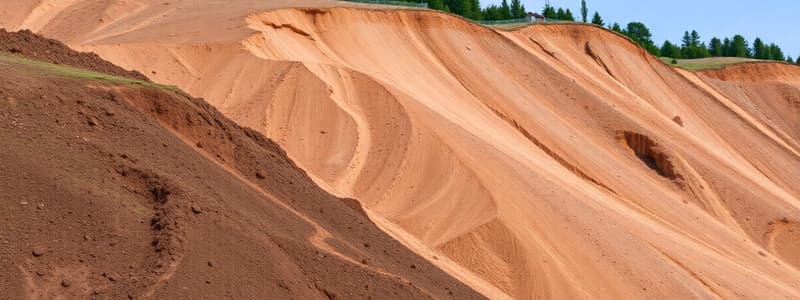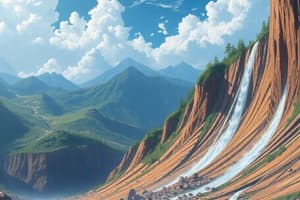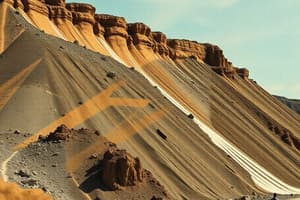Podcast
Questions and Answers
What type of soil movement is associated with wet soil moving over impermeable material?
What type of soil movement is associated with wet soil moving over impermeable material?
- Erosion
- Solifluction (correct)
- Soil creep
- Landslide
What is the relation between the moisture content of the material and the rate of mass movement?
What is the relation between the moisture content of the material and the rate of mass movement?
- Wetter material slows down the movement
- Dry material moves faster than wet material
- Wetter material generally increases the speed of movement (correct)
- Moisture content has no effect on mass movement
Which of the following best describes the term 'landslide'?
Which of the following best describes the term 'landslide'?
- Slow movement of soil over time
- Nonspecific rapid mass movements in rock or soil (correct)
- A specific type of soil erosion
- A controlled movement of earth material
What is a common consequence of soil creep?
What is a common consequence of soil creep?
What type of material is primarily involved in mass movements according to the content?
What type of material is primarily involved in mass movements according to the content?
Which phenomenon is closely related to mass movements but specifically involves icy materials?
Which phenomenon is closely related to mass movements but specifically involves icy materials?
What characterizes 'quick' or 'sensitive' clay in the context of mass movements?
What characterizes 'quick' or 'sensitive' clay in the context of mass movements?
What does the term 'mass movements' primarily refer to?
What does the term 'mass movements' primarily refer to?
How does the angle of repose affect sand dunes?
How does the angle of repose affect sand dunes?
What is the effect of water saturation in clay soils?
What is the effect of water saturation in clay soils?
Which clay type can expand significantly when wet, affecting slope stability?
Which clay type can expand significantly when wet, affecting slope stability?
What role does frost wedging play in mass movements?
What role does frost wedging play in mass movements?
What is a significant trigger for sudden landslides?
What is a significant trigger for sudden landslides?
How does frost heaving contribute to mass movements?
How does frost heaving contribute to mass movements?
What is the main consequence of soil expansion and contraction during wet and dry cycles?
What is the main consequence of soil expansion and contraction during wet and dry cycles?
What environmental factor can exacerbate bedrock sliding along bedding planes?
What environmental factor can exacerbate bedrock sliding along bedding planes?
Where are true quick clays most commonly found?
Where are true quick clays most commonly found?
What is the size of clay particles produced by glaciers?
What is the size of clay particles produced by glaciers?
Which type of mass movement specifically describes a free-falling action?
Which type of mass movement specifically describes a free-falling action?
What is the speed characteristic of rockfalls?
What is the speed characteristic of rockfalls?
Which of the following describes the movement of material during a rockslide?
Which of the following describes the movement of material during a rockslide?
What distinguishes flows from slides in terms of speed?
What distinguishes flows from slides in terms of speed?
Which of the following is NOT a type of flow?
Which of the following is NOT a type of flow?
What primarily contributes to the formation of rock flour in marine environments?
What primarily contributes to the formation of rock flour in marine environments?
What happens to sediment containing true quick clays after being deposited?
What happens to sediment containing true quick clays after being deposited?
Which kind of mass movement is most likely to occur on steep slopes?
Which kind of mass movement is most likely to occur on steep slopes?
Flashcards
Angle of repose
Angle of repose
The angle at which loose material, like sand on a dune, will naturally settle and remain stable.
Frost wedging
Frost wedging
A process where water seeps into cracks in rocks and freezes, expanding and putting pressure on the rock, eventually breaking it apart.
Frost heaving
Frost heaving
The upward movement of soil caused by the expansion of water as it freezes in the ground. This can disrupt the stability of a slope.
Downward pull
Downward pull
Signup and view all the flashcards
Friction
Friction
Signup and view all the flashcards
Saturated soil
Saturated soil
Signup and view all the flashcards
Montmorillonite
Montmorillonite
Signup and view all the flashcards
Landslide
Landslide
Signup and view all the flashcards
Soil creep
Soil creep
Signup and view all the flashcards
Solifluction
Solifluction
Signup and view all the flashcards
Quick clay
Quick clay
Signup and view all the flashcards
Landslide speed and moisture
Landslide speed and moisture
Signup and view all the flashcards
Landslide speed and casualties
Landslide speed and casualties
Signup and view all the flashcards
Materials involved in mass movement
Materials involved in mass movement
Signup and view all the flashcards
Classifying Mass Movements
Classifying Mass Movements
Signup and view all the flashcards
Fall
Fall
Signup and view all the flashcards
Rockfall
Rockfall
Signup and view all the flashcards
Slide
Slide
Signup and view all the flashcards
Slump
Slump
Signup and view all the flashcards
Flow
Flow
Signup and view all the flashcards
Snow Avalanche
Snow Avalanche
Signup and view all the flashcards
Debris Avalanche
Debris Avalanche
Signup and view all the flashcards
Nuée Ardente
Nuée Ardente
Signup and view all the flashcards
Mudflow
Mudflow
Signup and view all the flashcards
Study Notes
Mass Movements
- Mass movements, or mass wasting, are the various processes by which Earth materials are moved downslope.
- Gravity is the driving force behind these movements.
- These movements can be slow and subtle or sudden and devastating.
- Landslides (rapid) mass movements cause significant property damage and loss of life.
- Human activities can sometimes aggravate landslide risks.
- Landslides can happen in many areas, not just mountainous regions.
Factors Influencing Slope Stability
- Mass movements occur when the force of gravity overcomes the forces resisting it.
- Shearing stress is the pull of gravity.
- Friction or shear strength resists the movement.
- Slope angle is a major factor. Steeper slopes have higher shearing stress.
- Material properties (e.g., cohesion and friction) affect the ability of the material to resist sliding.
- Moisture content plays a significant role.
- Increased moisture can reduce friction and increase the likelihood of failure.
- Adding water to dry soil can increase adhesion and strength for a short time, in other cases reduce strength and increase vulnerability.
- Vegetation stabilizes slopes by binding the soil and absorbing moisture.
- Removal of vegetation can increase the risk of landslides.
- Tectonic movements can alter slope angles, potentially increasing landslide risk.
Effects of Fluids
- Moisture plays a dual role; it can increase or decrease stability.
- Small amounts of moisture increase adhesion in unconsolidated materials increasing their shear strength.
- Saturation reduces friction, lowering shear strength and increasing risk.
- Changes in pore-water pressure from rainfall or snowmelt can trigger slides.
Studying That Suits You
Use AI to generate personalized quizzes and flashcards to suit your learning preferences.
Related Documents
Description
Test your knowledge on soil movement, mass movements, and the properties of different soil types in this quiz. Explore concepts related to landslides, soil saturation, and the impact of moisture content on mass movements. Perfect for students studying geology and environmental science.




